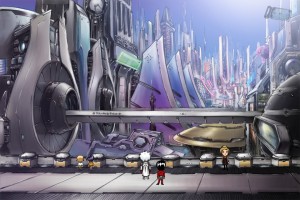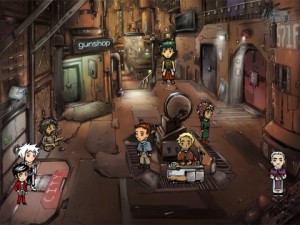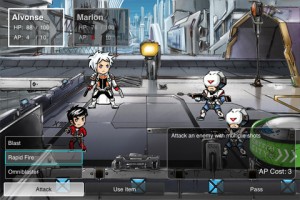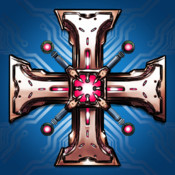Developer Kidalang has recently decided to see what would happen if you mixed the battle mechanics of Super Mario RPG with the heavy dialogue focus of a Visual Novel, titling the product of their experiment: Sage Fusion – Chapter 1: The Phantom of Liberty (out now, $2.99). The end result is a game that admittedly has far more reading to it than incidences of combat – especially since there are no random battles, with only fights directly connected to the plot occurring – but that’s really not a bad thing when your story is delivered this well. While I have sometimes praised games on iOS devices for managing to have grammatically correct English, as opposed to barely readable ‘Engrish’, Sage Fusion is a title that easily contends for the role of most intelligent literature on an iDevice that doesn’t also happen to be an eBook.
 Kidalang weaves together for us the tale of a far-flung future where mankind has already colonized and terraformed a vast number of planets, presently ruled by a government known as ‘The Union’. Helming up the mass bulk of commerce in this future is an elite order of interplanetary merchants commonly known as ‘The Circle’, a famously pretentious lot that had to bail out the ‘The Union’ during a debt situation in recent times. The third omnipresent organization is that of the ‘Neo-Vatican’, a monolithic religious organization that formed roughly 400 years ago at the end of a war that concluded with the construction of AIs being deemed a blasphemous act.
Kidalang weaves together for us the tale of a far-flung future where mankind has already colonized and terraformed a vast number of planets, presently ruled by a government known as ‘The Union’. Helming up the mass bulk of commerce in this future is an elite order of interplanetary merchants commonly known as ‘The Circle’, a famously pretentious lot that had to bail out the ‘The Union’ during a debt situation in recent times. The third omnipresent organization is that of the ‘Neo-Vatican’, a monolithic religious organization that formed roughly 400 years ago at the end of a war that concluded with the construction of AIs being deemed a blasphemous act.
Sage Fusion’s tale begins as we follow the titular spacecraft – operated by the wealthy Marlon Ziglar, a merchant with an extreme contempt for ‘The Circle’ – as the ship lands on the planet of Capistad in order to deliver a special shipment to a government official from ‘The Union’. Accompanying the merchant on this business trip is his recently hired bodyguard: Alvonse Brin, a softly-spoken – but immensely talented – gunslinger hailing from the somewhat backwater planet of Ginaz. While Marlon intends for their visit to the galactic capital to be just another routine business trip, what neither of them suspect is that a group of highly-trained spies are preparing to infiltrate the nearby Neo-Vatican at the exact same time.
 All of this is delivered through a plot that slowly – but constantly – adds details and nuances to the world and characters throughout the course of Sage Fusion, having seemingly inconsequential early events connect later on in ingenious ways you truly won’t see coming. Furthermore, Sage Fusion’s first chapter – while indeed ending on a ‘To Be Continued’ note – manages to thankfully avoid an overly common problem in games that are intentionally planned as multi-part episodic releases. By the time you have finished Chapter 1: The Phantom of Liberty you will feel as if you have learned a great deal about the political-climate of the galaxy – as well as the back stories of Marlon and his bodyguard – all while still being left chomping at the bit wanting to know what happens next when the game’s credits finish rolling, where as many other planned episodic series have a first chapter than can end leaving you feeling as if nothing of significance happened beyond some enigmatic foreshadowing.
All of this is delivered through a plot that slowly – but constantly – adds details and nuances to the world and characters throughout the course of Sage Fusion, having seemingly inconsequential early events connect later on in ingenious ways you truly won’t see coming. Furthermore, Sage Fusion’s first chapter – while indeed ending on a ‘To Be Continued’ note – manages to thankfully avoid an overly common problem in games that are intentionally planned as multi-part episodic releases. By the time you have finished Chapter 1: The Phantom of Liberty you will feel as if you have learned a great deal about the political-climate of the galaxy – as well as the back stories of Marlon and his bodyguard – all while still being left chomping at the bit wanting to know what happens next when the game’s credits finish rolling, where as many other planned episodic series have a first chapter than can end leaving you feeling as if nothing of significance happened beyond some enigmatic foreshadowing.
However – enough about Sage Fusion’s impeccably delivered plot – it’s time to move on to matters of the aforementioned combat engine, of which I will reiterate that random encounters/grinding do not occur here. The game uses a Super Mario RPG esque mechanic to determine hit effectiveness, wherein the closer a player taps an icon before an attack executes – either theirs, or an enemy’s – the more damage that will either be dealt or absorbed. Since no grinding occurs during the course of Sage Fusion, the key factor to determining whether or not a gamer wins the harder fights near the end of the plot will be determined entirely by how well one masters the blocking/striking system.
 It is of particular importance to note that blocking incoming attacks is not only vital to mitigating incoming damage, for successfully shielding against enemy strikes is also how Sage Fusion’s Action Point gauge is refilled. The amount of Action Points on hand determines which attacks/items a character is able to use during their turn, and a hero with virtually no AP on hand will only be able to use the most piddling of attacks that round. One thing Players will definitely never need to worry about – however – is having to carefully meter out the party’s health items, for they can freely be found throughout Sage Fusion in generous volumes.
It is of particular importance to note that blocking incoming attacks is not only vital to mitigating incoming damage, for successfully shielding against enemy strikes is also how Sage Fusion’s Action Point gauge is refilled. The amount of Action Points on hand determines which attacks/items a character is able to use during their turn, and a hero with virtually no AP on hand will only be able to use the most piddling of attacks that round. One thing Players will definitely never need to worry about – however – is having to carefully meter out the party’s health items, for they can freely be found throughout Sage Fusion in generous volumes.
While there are no experience points to be gained from grinding in Sage Fusion – or even any experience points to be earned at all, for that matter – all of the game’s playable characters will naturally expand their repertoire of abilities in response to the plot’s progression. For the most part this makes the learning of new combat manuevers feel like a natural result of Sage Fusion’s plot, unlike how in most other RPGs where the expanding abilities of the heroes only ever truly make sense in terms of game mechanics. This also has the nice added benefit that you will never need to worry about scouring online FAQs in order to learn about how to obtusely obtain a character’s ultimate skill before it should somehow become permanently unobtainable.
Outside of combat the game plays more like a classical third-person perspective PC Graphic Adventure game, except with a focus far more heavily placed on lengthy conversations than solving puzzles (although those exist here as well). It is during these portions of Sage Fusion where the amazing art design of the background scenery truly gets to shine, bringing to life all of the varied futuristic locations that the player travels to with beautifully detailed hand drawn artwork. Even better yet, although generally not explicitly required, much of this background scenery – the same as with the aforementioned classical graphic adventure games – can be tapped on to have Marlon and his bodyguard comment on what they’re seeing.
iFanzine Verdict: Where as many other iOS games feature stories tacked on at the eleventh hour – often with questionable grammar – in Sage Fusion the plot was the first and primary concern, and is delivered with a level of writing maturity that could have easily been used to successfully push a series of successful sci-fi novels. The world that developer Kidalang has already painted so well with words alone is then further realized by the amazing hand drawn artwork seen during all of the background scenery that beautifully brings the planet of Capistad to vibrant life. The included combat engine successfully takes a page from Super Mario RPG to ensure that the battles are never a passive lather-rinse-repeat snooze fest, and these fights furthermore only happen as logical parts of the plot. It is this fact that leads to my only minor cautioning to people: while RPGs have never been the most ideal fit for the quick-play mentality that the iOS market thrives upon, Sage Fusion is a game where – depending on how fast you read – you could easily go through an entire lunch break without seeing a single drop of combat occur.


